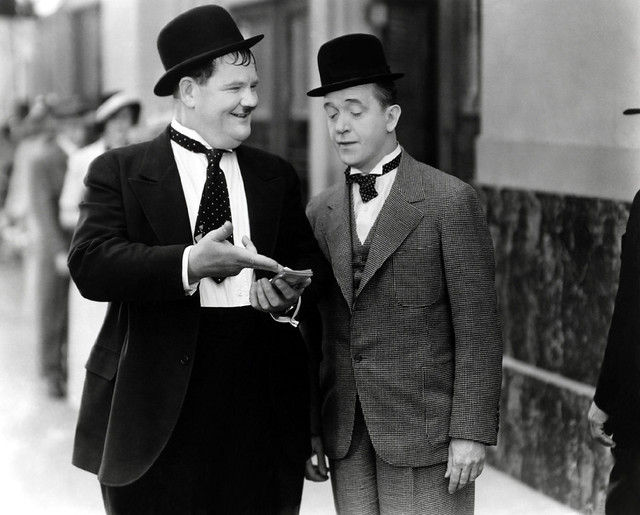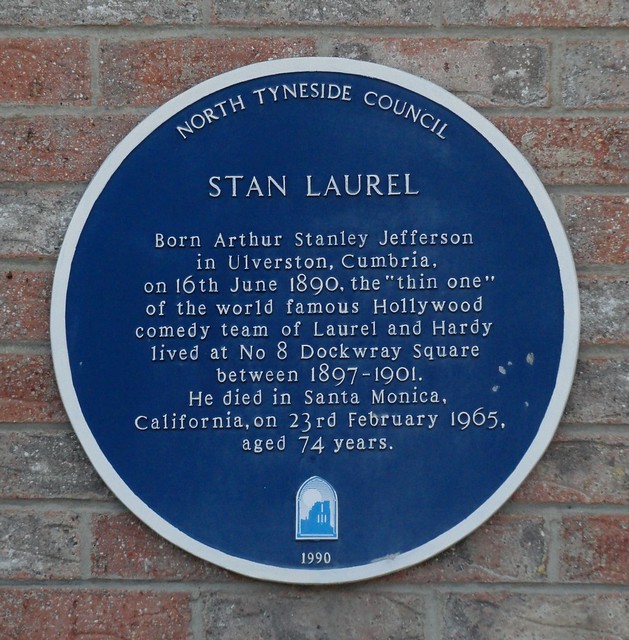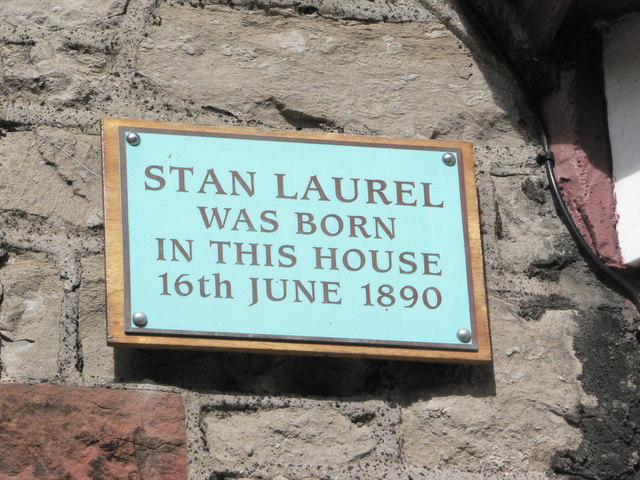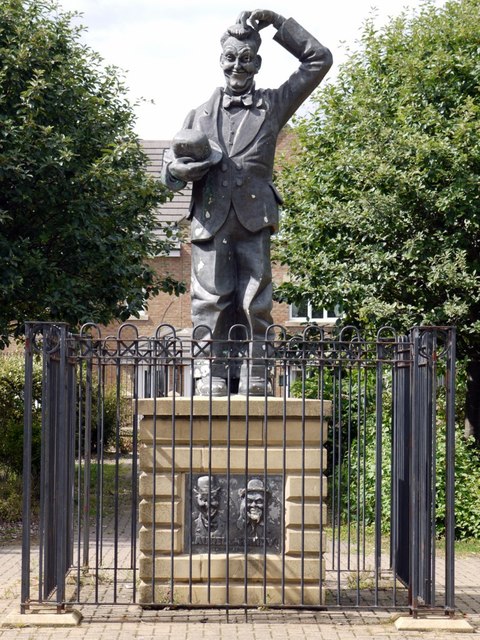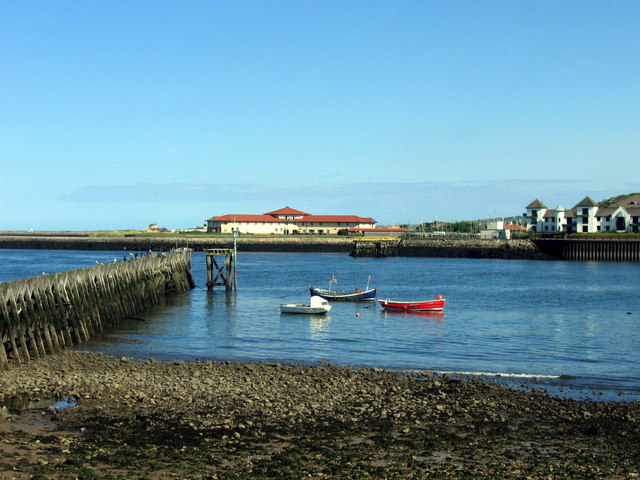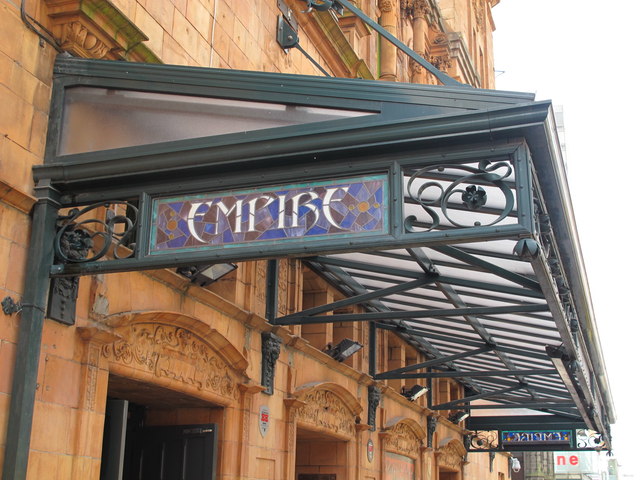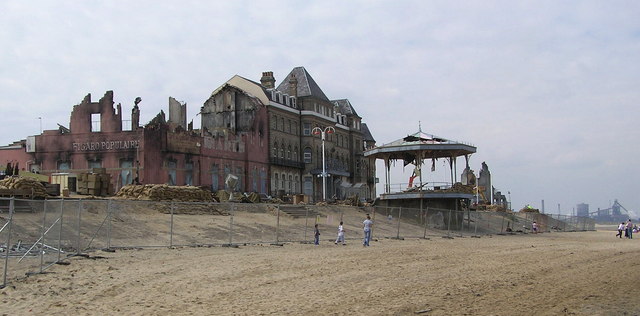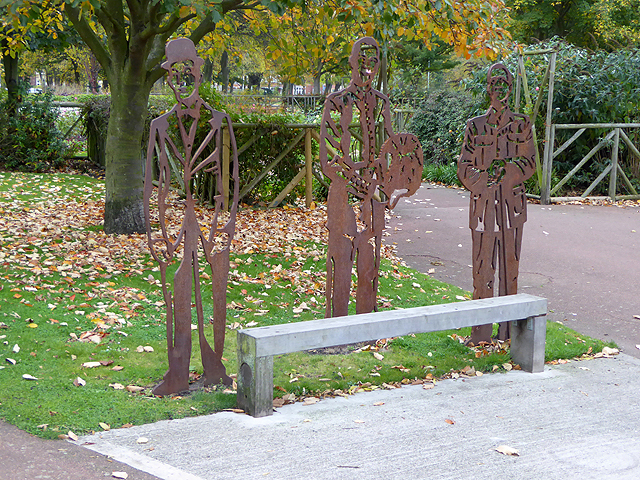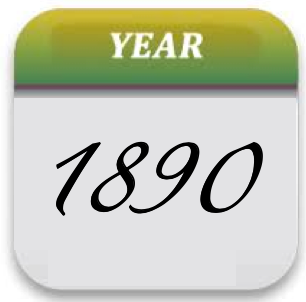Topics > People in History > Stan Laurel (1890 - 1965)
Stan Laurel (1890 - 1965)
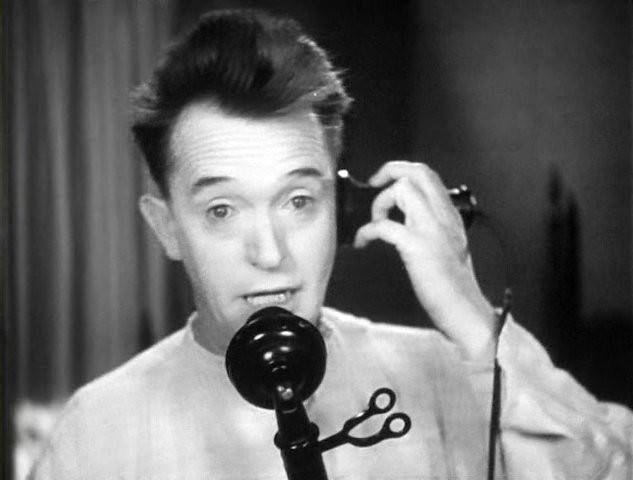 Stan Laurel of the early film comedian duo Laurel and Hardy was born Arthur Stanley Jefferson in Ulverston, Cumbria in 1890. From 1897 to 1901 Stan lived at No. 8 Dockwray Square in North Shields. He attended Gainford Academy and then King James I Grammar School in Bishop Auckland and King's School, Tynemouth. He worked on the British music hall circuit and was silent comedian Charlie Chaplin's understudy for a time, before spending the bulk of his career in the USA. Stan Laurel and Oliver Hardy visited Britain in 1932 including Tynemouth.
Stan Laurel of the early film comedian duo Laurel and Hardy was born Arthur Stanley Jefferson in Ulverston, Cumbria in 1890. From 1897 to 1901 Stan lived at No. 8 Dockwray Square in North Shields. He attended Gainford Academy and then King James I Grammar School in Bishop Auckland and King's School, Tynemouth. He worked on the British music hall circuit and was silent comedian Charlie Chaplin's understudy for a time, before spending the bulk of his career in the USA. Stan Laurel and Oliver Hardy visited Britain in 1932 including Tynemouth.
Stan Laurel (born Arthur Stanley Jefferson; 16 June 1890 – 23 February 1965) was a British comic actor, writer and film director, who was part of the comedy duo Laurel and Hardy. He appeared with his comedy partner Oliver Hardy in 107 short films, feature films, and cameo roles.
Laurel began his career in music hall, where he developed a number of his standard comic devices: the bowler hat, the deep comic gravity and the nonsensical understatement. His performances polished his skills at pantomime and music hall sketches. Laurel was a member of "Fred Karno's Army", where he was Charlie Chaplin's understudy. With Chaplin, the two arrived in the United States on the same ship from the United Kingdom with the Karno troupe. Laurel began his film career in 1917 and made his final appearance in 1951. From 1928 onwards, he appeared exclusively with Hardy. Laurel officially retired from the screen following his comedy partner's death in 1957.
In 1961, Laurel was given a Lifetime Achievement Academy Award for his pioneering work in comedy. He has a star on the Hollywood Walk of Fame at 7021 Hollywood Blvd. Laurel and Hardy ranked top among best double acts and seventh overall in a 2005 UK poll to find the Comedians' Comedian. In 2009, a bronze statue of the duo was unveiled in Laurel's home town of Ulverston.
Early life
Arthur Stanley Jefferson was born in his grandparents' house on 16 June 1890 in Argyll Street, Ulverston, Lancashire, to Arthur Jefferson, a theatre manager from Bishop Auckland, and Margaret (née Metcalfe), an actress from Ulverston. He was one of five children.
His parents were both active in the theatre and always very busy. In his early years, the boy spent much time living with his maternal grandmother, Sarah Metcalfe. He attended school at King James I Grammar School in Bishop Auckland, County Durham and the King's School in Tynemouth, Northumberland.
He moved with his parents to Glasgow, Scotland, where he completed his education at Rutherglen Academy. His father managed Glasgow's Metropole Theatre, where Laurel began work. His boyhood hero was Dan Leno, one of the greatest English music hall comedians. With a natural affinity for the theatre, Laurel gave his first professional performance on stage at the Panopticon in Glasgow at the age of sixteen, where he polished his skills at pantomime and music hall sketches. It was the music hall from where he drew his standard comic devices, including his bowler hat and nonsensical understatement.
He joined Fred Karno's troupe of actors in 1910 with the stage name of "Stan Jefferson"; the troupe also included a young Charlie Chaplin. The music hall nurtured him, and he acted as Chaplin's understudy for some time. Karno was a pioneer of slapstick, and in his biography Laurel stated, "Fred Karno didn't teach Charlie [Chaplin] and me all we know about comedy. He just taught us most of it". Chaplin and Laurel arrived in the United States on the same ship from Britain with the Karno troupe and toured the country.
During the First World War, Laurel registered for military service in America on 5 June 1917, as required under the Selective Service Act. He was not called up; his registration card states resident alien and deafness as exemptions.
Between 1916 and 1918, he teamed up with Alice Cooke and Baldwin Cooke, who became his lifelong friends. Amongst other performers, Laurel worked briefly alongside Oliver Hardy before the two were a team in the silent film short The Lucky Dog (1921). It was around this time that Laurel met Mae Dahlberg. Around the same time, he adopted the stage name of Laurel at Dahlberg's suggestion that his stage name Stan Jefferson was unlucky, due to it having thirteen letters. The pair were performing together when Laurel was offered $75 a week to star in two-reel comedies. After making his first film Nuts in May, Universal offered him a contract. The contract was soon cancelled during a reorganisation at the studio. Among the films in which Dahlberg and Laurel appeared together was the 1922 parody Mud and Sand.
By 1924, Laurel had given up the stage for full-time film work, under contract with Joe Rock for 12 two-reel comedies. The contract had one unusual stipulation: that Dahlberg was not to appear in any of the films. Rock thought that her temperament was hindering Laurel's career. In 1925, she started interfering with Laurel's work, so Rock offered her a cash settlement and a one-way ticket back to her native Australia, which she accepted. The 12 two-reel comedies were Mandarin Mix-Up (1924), Detained (1924), Monsieur Don't Care (1924), West of Hot Dog (1924), Somewhere in Wrong (1925), Twins (1925), Pie-Eyed (1925), The Snow Hawk (1925), Navy Blue Days (1925), The Sleuth (1925), Dr. Pyckle and Mr. Pryde (1925), Half a Man (1925).
Laurel and Hardy
Laurel and Hardy in Lucky Dog.jpg|thumb|left|Laurel with Hardy in The Lucky Dog (1921), long before they became a team.
Laurel next signed with the Hal Roach studio, where he began directing films, including a 1926 production called Yes, Yes, Nanette. He intended to work primarily as a writer and director.
Oliver Hardy, another member of the Hal Roach Studios Comedy All Star players, was injured in a kitchen mishap in 1927, and Laurel was asked to return to acting. Laurel and Hardy began sharing the screen in Slipping Wives, Duck Soup (1927), and With Love and Hisses. The two became friends and their comic chemistry soon became obvious. Roach Studios' supervising director Leo McCarey noticed the audience reaction to them and began teaming them, leading to the creation of the Laurel and Hardy series later that year.
Together, the two men began producing a huge body of short films, including The Battle of the Century, Should Married Men Go Home?, Two Tars, Be Big!, Big Business, and many others. Laurel and Hardy successfully made the transition to talking films with the short Unaccustomed As We Are in 1929. They also appeared in their first feature in one of the revue sequences of The Hollywood Revue of 1929, and the following year they appeared as the comic relief in the lavish all-colour (in Technicolor) musical feature The Rogue Song. Their first starring feature Pardon Us was released in 1931. They continued to make both features and shorts until 1935, including their 1932 three-reeler The Music Box, which won an Academy Award for Best Short Subject.
Trouble at Roach Studio
During the 1930s, Laurel was involved in a dispute with Hal Roach which resulted in the termination of his contract. Roach maintained separate contracts for Laurel and Hardy that expired at different times, so Hardy remained at the studio and was "teamed" with Harry Langdon for the 1939 film Zenobia. The studio discussed a series of films co-starring Hardy with Patsy Kelly to be called "The Hardy Family." But Laurel sued Roach over the contract dispute. Eventually, the case was dropped and Laurel returned to Roach. The first film that Laurel and Hardy made after Laurel returned was A Chump at Oxford. Subsequently, they made Saps at Sea, which was their last film for Roach.
20th Century Fox
In 1941, Laurel and Hardy signed a contract at 20th Century Fox to make ten films over five years. During the war years, their work became more standardised and less successful, though The Bullfighters and Jitterbugs did receive some praise.
In 1947, Laurel returned to England when he and Hardy went on a six-week tour of the United Kingdom, and the duo were mobbed wherever they went. Laurel's homecoming to Ulverston took place in May, and the duo were greeted by thousands of fans outside the Coronation Hall. The Evening Mail noted: "Oliver Hardy remarked to our reporter that Stan had talked about Ulverston for the past 22 years and he thought he had to see it." The tour included a Royal Command Performance for King George VI and Queen Elizabeth in London. The success of the tour led them to spend the next seven years touring the UK and Europe.
Around this time, Laurel found out that he had diabetes, so he encouraged Hardy to find solo projects which he did, taking parts in John Wayne and Bing Crosby films.
In 1950, Laurel and Hardy were invited to France to make a feature film. The film was a disaster, a Franco-Italian co-production titled Atoll K. (The film was entitled Utopia in the US and Robinson Crusoeland in the UK.) Both stars were noticeably ill during the filming. Upon returning to the United States, they spent most of their time recovering. In 1952, Laurel and Hardy toured Europe successfully, and they returned in 1953 for another tour of the continent. During this tour, Laurel fell ill and was unable to perform for several weeks.
In May 1954, Hardy had a heart attack and cancelled the tour. In 1955, they were planning to do a television series called Laurel and Hardy's Fabulous Fables based on children's stories. The plans were delayed after Laurel suffered a stroke on 25 April 1955, from which he recovered. But as the team was planning to get back to work, his partner Hardy had a massive stroke on 14 September 1956, which resulted in his being unable to return to acting.
Hardy's death
Oliver Hardy died on 7 August 1957. Laurel was too ill to attend his funeral and said, "Babe would understand". People who knew Laurel said that he was devastated by Hardy's death and never fully recovered from it. He refused to perform on stage or act in another film without his friend, although he continued to socialise with his fans.
After Laurel and Hardy
In 1961, Stan Laurel was given a Lifetime Achievement Academy Award for his pioneering work in comedy. He had achieved his lifelong dream as a comedian and had been involved in nearly 190 films. He lived his final years in a small flat in the Oceana Apartments in Santa Monica, California.
Laurel was always gracious to fans and spent much time answering fan mail. His phone number (OXford-0614) was listed in the telephone directory, and fans were amazed that they could dial the number and speak to him directly.
Jerry Lewis was among the numerous comedians to visit Laurel, who offered suggestions for Lewis's production of The Bellboy (1960). Lewis paid tribute to Laurel by naming his main character Stanley in the film, and having Bill Richmond play a version of Laurel as well. Dick Van Dyke told a similar story. When he was just starting his career, he looked up Laurel's phone number, called him, and then visited him at his home. Van Dyke played Laurel on "The Sam Pomerantz Scandals" episode of The Dick Van Dyke Show.
Laurel was offered a cameo role in It's a Mad, Mad, Mad, Mad World (1963), but turned it down. He did not want to be on screen in his old age, especially without Hardy.
Personal life
Laurel and Mae Charlotte Dahlberg never married, but lived together as common-law husband and wife from 1919 to 1925, before Dahlberg accepted a one-way ticket from Joe Rock to go back to her native Australia. In November 1937, Dahlberg was back in the USA and sued the now successful Stan Laurel for financial support. At the time, Laurel's second marriage was in the process of a divorce, with Dahlberg's legal suit adding to Laurel's woes. The matter was settled out of court. Dahlberg was described as a "relief project worker" by the court.
Laurel had four wives and married one of them a second time after their divorce.
Laurel married his first wife, Lois Neilson, on 13 August 1926. On 10 December 1927, during the early years of Laurel and Hardy's partnership, Laurel and Neilson had a baby daughter, also named Lois. In May 1930, their second child, a son named Stanley, was born two months premature and died after nine days. Laurel's daughter Lois died on 27 July 2017, aged 89. Laurel and Neilson divorced in December 1934.
In 1935, Laurel married Virginia Ruth Rogers (known as Ruth). In 1937, Laurel filed for divorce from Ruth, confessing that he was not over his ex-wife Lois, but Lois decided against a reconciliation. On New Year's Day 1938, Laurel married Vera Ivanova Shuvalova (known as Illeana), leading to an irate Ruth accusing Stan of bigamy, but their divorce had been finalised a couple of days before his new marriage. The new marriage was very volatile. Illeana accused him of trying to bury her alive in the backyard of their San Fernando Valley home. He and Illeana separated in 1939 and divorced in 1940, with Illeana surrendering all claim to the Laurel surname on 1 February 1940, in exchange for $6,500. In 1941, Laurel remarried Virginia Ruth Rogers, with Laurel and Ruth divorcing for the second time in early 1946.
On 6 May 1946, Laurel married Ida Kitaeva Raphael, to whom he remained married until his death.
Death
Laurel was a heavy smoker until suddenly quitting around 1960. In January 1965, he underwent a series of x-rays for an infection on the roof of his mouth. He died on 23 February 1965, aged 74, four days after suffering a heart attack on 19 February. Minutes before his death, Laurel told his nurse that he would not mind going skiing; surprised, the nurse replied that she was not aware that he was a skier. "I'm not," said Laurel, "I'd rather be doing that than this!" A few minutes later, the nurse looked in on him again and found that he had died quietly in his armchair.
At his funeral, silent screen comedian Buster Keaton was overheard talking about Laurel's talent: "Chaplin wasn't the funniest, I wasn't the funniest, this man was the funniest." Dick Van Dyke gave the eulogy at Laurel's funeral, as a friend, protégé, and occasional impressionist of Laurel during his later years; he read "The Clown's Prayer". Laurel had earlier quipped: "If anyone at my funeral has a long face, I'll never speak to him again." Laurel was cremated and his ashes were interred in Forest Lawn-Hollywood Hills Cemetery.
Legacy and honours
Laurel and Hardy are featured on the cover of the Beatles' album Sgt. Pepper's Lonely Hearts Club Band (1967). In 1989, a statue of Laurel was erected in Dockwray Square, North Shields, Tyne and Wear, England where he lived at No. 8 from 1897 to 1902. The steps down from the Square to the North Shields Fish Quay were said to have inspired the piano-moving scene in The Music Box. In a 2005 UK poll, Comedians' Comedian, Laurel and Hardy were ranked top double act, and seventh overall. Along with Hardy, Laurel was inducted into the Grand Order of Water Rats.
Neil Brand wrote a radio play entitled Stan, broadcast in 2004 on BBC Radio 4 and subsequently on BBC Radio 4 Extra, starring Tom Courtenay as Stan Laurel, in which Stan visits Oliver Hardy after Hardy has suffered his stroke and tries to say the things to his dying friend and partner that have been left unsaid. In 2006, BBC Four showed a drama called Stan, based on Brand's radio play, in which Laurel meets Hardy on his deathbed and reminisces about their career.
A plaque on the Bull Inn, Bottesford, Leicestershire, England, marks Laurel and Hardy appearing in Nottingham over Christmas 1952, and staying with Laurel's sister, Olga, who was the landlady of the pub. In 2008, a statue of Stan Laurel was unveiled in Bishop Auckland, County Durham, on the site of the Eden Theatre. In April 2009, a bronze statue of Laurel and Hardy was unveiled in Ulverston.
There is a Laurel and Hardy Museum in Stan's hometown of Ulverston. There are two Laurel and Hardy museums in Hardy's hometown of Harlem, Georgia. One is operated by the town of Harlem, and the other is a private museum owned and operated by Gary Russeth, a Harlem resident.
In 2013, Gail Louw and Jeffrey Holland debuted a short one-man play "...And this is my friend Mr Laurel" at the Camden Fringe festival. The play, starring Holland as Laurel, was taken on tour of the UK in 2014 until June 2015.
In an upcoming film, Stan & Ollie, Laurel will be played by English comedian Steve Coogan, and Hardy by American actor John C. Reilly. Developed by BBC Films, the film is set in the twilight of their careers, and will focus on their farewell tour of Britain's variety halls in 1953.
Visit the page: Stan Laurel for references and further details. You can contribute to this article on Wikipedia.
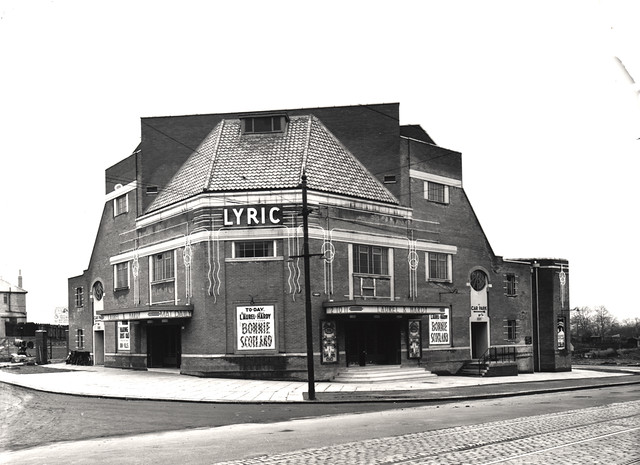
from Newcastle libraries (flickr)
049840:Lyric cinema Stephenson Road Heaton Unknown 1936
Pinned by Simon Cotterill

from http://commons.wikimedia.org/…
Statue of Stan Laurel in Bishop Auckland
- Statue of Stan Laurel on the site once occupied by the theatre owned by his parents. Photo by Pit-yacker.
Added by
Simon Cotterill

Co-Curate Page
Lyric Cinema
- Overview Map Street View "The Lyric Cinema opened on 6th January 1936 with Shirley Temple in "The Little Colonel". The building has an imposing corner location and has two entrances, …

from Youtube (youtube)
Stanlio Ollio - Laurel Hardy in Tynemouth ("Grand Hotel")
Pinned by Pat Thomson
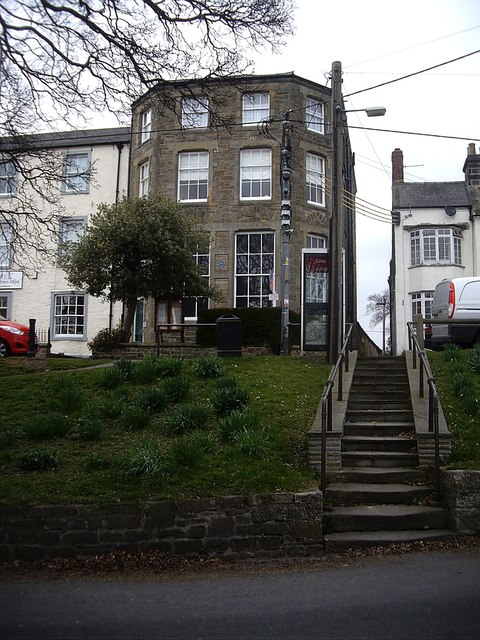
Co-Curate Page
Academy Theatre
- Overview Map Street View Academy Theatre, located off High Green in Gainford, was once a boys boarding school. Gainford Academy, founded by Rev. William Bowman, operated from this building from …
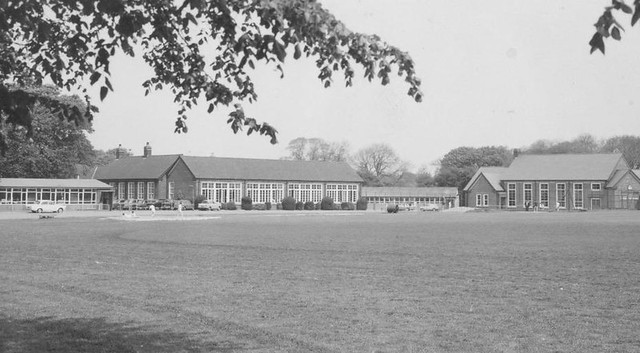
Co-Curate Page
King James I Academy, Bishop Auckland
- Overview About King James I Academy Map Street View King James I Academy is located on South Church Road, Bishop Auckland. The school's history can be traced back to 1605. …
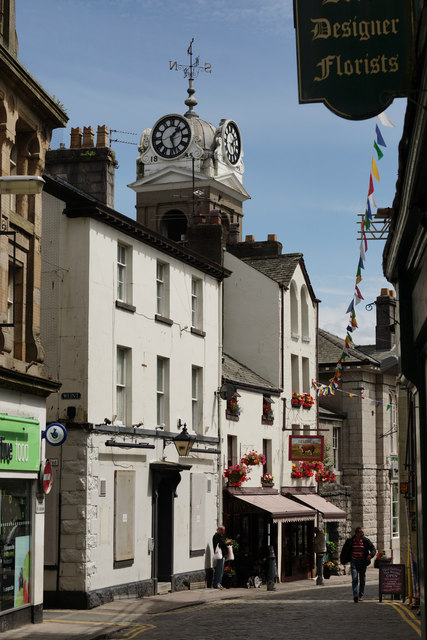
Co-Curate Page
Ulverston
- Overview About Ulverston Map Street View Ulverston is a market town in the South Lakeland district of Cumbria. Help build the Ulverston Timeline Ulverston is a market town in the …


from Newcastle libraries (flickr)
049840:Lyric cinema Stephenson Road Heaton Unknown 1936
Pinned by Simon Cotterill

from http://commons.wikimedia.org/…
Statue of Stan Laurel in Bishop Auckland
- Statue of Stan Laurel on the site once occupied by the theatre owned by his parents. Photo by Pit-yacker.
Added by
Simon Cotterill

Co-Curate Page
Lyric Cinema
- Overview Map Street View "The Lyric Cinema opened on 6th January 1936 with Shirley Temple in "The Little Colonel". The building has an imposing corner location and has two entrances, …

from Youtube (youtube)
Stanlio Ollio - Laurel Hardy in Tynemouth ("Grand Hotel")
Pinned by Pat Thomson

Co-Curate Page
Academy Theatre
- Overview Map Street View Academy Theatre, located off High Green in Gainford, was once a boys boarding school. Gainford Academy, founded by Rev. William Bowman, operated from this building from …

Co-Curate Page
King James I Academy, Bishop Auckland
- Overview About King James I Academy Map Street View King James I Academy is located on South Church Road, Bishop Auckland. The school's history can be traced back to 1605. …


